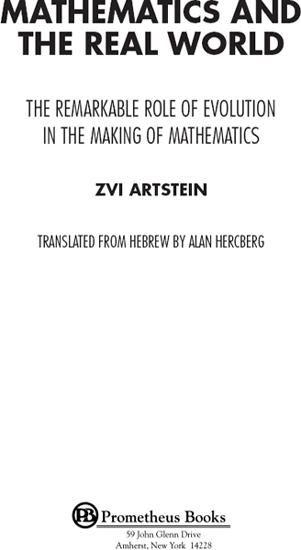Mathematics and the Real World
Read Mathematics and the Real World Online
Authors: Zvi Artstein


Published 2014 by Prometheus Books
Mathematics and the Real World: The Remarkable Role of Evolution in the Making of Mathematics
. Copyright © 2014 by Zvi Artstein. All rights reserved. No part of this publication may be reproduced, stored in a retrieval system, or transmitted in any form or by any means, digital, electronic, mechanical, photocopying, recording, or otherwise, or conveyed via the Internet or a website without prior written permission of the publisher, except in the case of brief quotations embodied in critical articles and reviews.
Hakesher Hamatemati: Hamatematika shell Hateva, Hateva shell Hamatematika, ve-Hazika La-evolutzia
© Zvi Artstein / Books in the Attic / Yediot Books, 2014
10 Kehilat Venezia St., Tel Aviv, Israel 6143401
Prometheus Books recognizes the following registered trademarks mentioned within the text: IBM®, NBA®; and Philadelphia 76ers®.
Cover images: spiral © Yang MingQi/Media Bakery; numbers © Chen Ping-Hung/Media Bakery; drawing in the upper left by Leonardo da Vinci, folio 518 recto, from the Biblioteca Ambrosiana in Milan, Italy
Jacket design by Jacqueline Nasso Cooke
Translated from the original Hebrew by Alan Hercberg
Unless otherwise specified, all images are by the author
Inquiries should be addressed to
Prometheus Books
59 John Glenn Drive
Amherst, New York 14228
VOICE: 716–691–0133 • FAX: 716–691–0137
WWW.PROMETHEUSBOOKS.COM
18 17 16 15 14 5 4 3 2 1
The Library of Congress has cataloged the printed edition as follows:
Artstein, Zvi, 1943– author.
[Hakesher hamatemati. English]
Mathematics and the real world : the remarkable role of evolution in the making of mathematics / by Zvi Artstein ; translated from Hebrew by Alan Hercberg.
pages cm
Includes bibliographical references and index.
ISBN 978-1-61614-091-5 (hardback) — ISBN 978-1-61614-546-0 (ebook)
1. Mathematics—Philosophy. I. Title.
QC6.A6913 2014
510.9—dc23
2014013908
Printed in the United States of America
CHAPTER I. EVOLUTION, MATHEMATICS, AND THE EVOLUTION OF MATHEMATICS
2. Mathematical Ability in the Animal World
3. Mathematical Ability in Humans
4. Mathematics That Yields Evolutionary Advantage
5. Mathematics with No Evolutionary Advantage
6. Mathematics in Early Civilizations
CHAPTER II. MATHEMATICS AND THE GREEKS’ VIEW OF THE WORLD
9. The Origin of Basic Science: Asking Questions
10. The First Mathematical Models
11. Platonism versus Formalism
12. Models of the Heavenly Bodies
13. On the Greek Perception of Science
14. Models of the Heavenly Bodies (Cont.)
CHAPTER III. MATHEMATICS AND THE VIEW OF THE WORLD IN EARLY MODERN TIMES
15. The Sun Reverts to the Center
19. Everything You Wanted to Know about Infinitesimal Calculus and Differential Equations
21. Purpose: The Principle of Least Action
23. On the Perception of Science in Modern Times
CHAPTER IV. MATHEMATICS AND THE MODERN VIEW OF THE WORLD
26. Discrepancy between Maxwell's Theory and Newton's Theory
29. The Discovery of the Quantum State of Nature
34. The Scientific Method: Is There an Alternative?
CHAPTER V. THE MATHEMATICS OF RANDOMNESS
35. Evolution and Randomness in the Animal World
36. Probability and Gambling in Ancient Times
39. The Mathematics of Predictions and Errors
40. The Mathematics of Learning from Experience
41. The Formalism of Probability
42. Intuition versus the Mathematics of Randomness
43. Intuition versus the Statistics of Randomness
CHAPTER VI. THE MATHEMATICS OF HUMAN BEHAVIOR
46. The Aggregation of Preferences and Voting Systems
47. The Mathematics of Confrontation
49. Decisions in a State of Uncertainty
CHAPTER VII. COMPUTATIONS AND COMPUTERS
51. Mathematics for Computations
53. The Mathematics of Computations
54. Proofs with High Probability
CHAPTER VIII. IS THERE REALLY NO DOUBT?
57. Mathematics without Axioms
58. Rigorous Development without Geometry
59. Numbers as Sets, Logic as Sets
CHAPTER IX. THE NATURE OF RESEARCH IN MATHEMATICS
62. How Does a Mathematician Think?
63. On Research in Mathematics
64. Pure Mathematics vis-à-vis Applied Mathematics
65. The Beauty, Efficiency, and Universality of Mathematics
CHAPTER X. WHY IS TEACHING AND LEARNING MATHEMATICS SO HARD?
67. Mathematical Thinking: There Is No Such Thing
69. A Logical Structure vis-à-vis a Structure for Teaching
70. What Is Hard in Teaching Mathematics?
71. The Many Facets of Mathematics
There are many jokes about mathematicians. One of my favorites is about an engineer, an architect, and a mathematician who have been sentenced to be hanged. In the evening before the day set for the execution, the warden asks them for their last requests. The engineer asks to be allowed to present a new machine he has designed that can perform all household chores without any human intervention. The warden promises that the next day, before the hanging, he will have one hour in which to show his machine to the prison staff and his two fellow death-row inmates. The architect asks to be allowed to explain his new concept of residential accommodation, a modern house that keeps cool in the summer and warm in the winter, without expenditure on fuel. Again the warden promises that the next day, before the hanging, he will have one hour in which to present his idea to the prison staff and his two fellow death-row prisoners. The mathematician says that he has recently proved a mathematical theorem that will shake the foundations of mathematics, and he would like to reveal it in a lecture to an intelligent audience. The warden starts agreeing…and the engineer and the architect start shouting: “We want our execution to be brought forward to this evening!”





